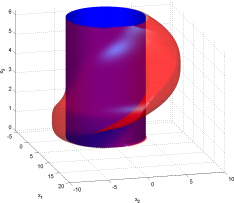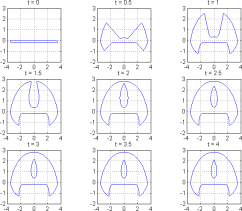A Toolbox of Level Set Methods
version 1.1.1
Version 1.1.1
Primarily a bug fix version.
A few new functions were added to the kernel: deleteDimension,
downsampleGrid, dividedDifferenceTable and getCellIndexes. For more
details on these functions, see their help entries.
The user manual has not been
updated for version 1.1.1.
Download the toolbox
For those who prefer pictures:
Important Notes
- The Toolbox requires
basic Matlab.
No additional toolboxes are needed.
- Version 1.1.1 of ToolboxLS definitely works with Matlab Versions
7.14 (R2012a) and 7.11 (R2012b).
- Version 1.1 of ToolboxLS definitely works with Matlab Versions
6.5, 7.2 (R2006a) and 7.5 (R2007b).
- Other versions of Matlab have not been directly tested.
- The Toolbox is not a tutorial on level set methods. For that
purpose I recommend [1] and/or [2]. Because the Toolbox focuses on
regular grids and time-dependent PDEs, it follows [1] more closely.
- If you find the Toolbox useful, please send me an email (mitchell
(at) cs.ubc.ca). The more people who use the toolbox, the more
justification I have for continuing its development.
|

Growing Set: avi mpg
Final Set: avi mpg
|
More Details
Level set methods are a class of numerical algorithms for
simulation of dynamic implicit surfaces and approximation of solutions
to the Hamilton-Jacobi (HJ) partial differential equation (PDE).
These algorithms have application in such fields as:
- Computational Geometry and Mesh Generation.
- Differential Games.
- Dynamic Programming.
- Financial Mathematics.
- Fluid and Combustion Simulation.
- Graphics.
- Image Processing and Computer Vision.
- Robotics and Control.
- Verification and Reachable Sets.
Compared to their competitors, level set methods can be relatively
easy to implement. However, picking through the literature to find
all the gory details of high accuracy methods, and then debugging the
code in three dimensions (or more) is a slow process at best.
This Toolbox is designed to minimize the sum of coding, execution
and analysis time for those who want to explore level set methods.
Computationally, Matlab is not the fastest environment in which to
solve PDEs, but as a researcher I have found that the enviroment has
several important advantages over faster compiled implementations:
- Built in visualization, including three dimensional isosurfaces.
- Fully functional debugger, including the ability to visualize two
and three dimensional surfaces while debugging.
- No compilation is required, so it is easy to write scripts,
construct initial conditions and examine results interactively.
- All the source code for the Toolbox is provided (as m-files).
- Kernel code can be written in a dimensionally independent manner.
- Execution time is quite reasonable (even for three dimensional
problems), through the use of Matlab's "vectorization" and restriction
of the computational domain to regular Euclidean grids.
The Toolbox is not a tutorial on level set methods. Users
unfamiliar with these algorithms should consult one or both of the
textbooks [1],[2] (or the academic literature cited therein). Because
of the focus of the current version of the toolbox, it follows [1]
more closely.
In addition to examples which demonstrate the basic features of the
toolbox, recreations of examples from [1] and [2] are included, as
well as solutions of general time-dependent HJ PDEs and calculations
of reachable sets.
References
|

Growing Set: avi mpg


Growing Set: avi mpg
|
Email Me If You
- Find the Toolbox useful for something. When it comes time to
justify my research agenda to granting agencies and the university,
the popularity of my software package(s) will definitely help. If you
can tell me how you use the Toolbox and how to improve it, all the
better.
- Would like to be informed of future releases.
- Find a bug in the toolbox. I will need a (small sized) example of
the code which recreates the bug. Note that numerical instability
(the level set function blows up) is usually caused by incorrect
driver code (initialization, boundary conditions, dynamics or CFL
choice), not by kernel code.
- Implement a useful feature. External contributions to the toolbox
are welcome, although documentation will be needed.
- Would like a feature implemented. I cannot implement all
requests, but I will try to implement popular ones.
My email address is: mitchell (at) cs.ubc.ca
|

|
Additional Code
Some additional code selections from publications. By clicking on any
of these links, you agree that the license
terms applicable to the Toolbox of Level Set Methods also applies
to this additional code that you download.
Related Publications and Citing the Toolbox
Here are some papers related to the Toolbox which may contain
material that does not appear in the Toolbox documentation.
Also, citations matter to my academic career, so if you have used
the Toolbox in research that will be published, please choose a
citation appropriate to the field of publication from the list below.
While citations and links to the web site are greatly appreciated,
please do not use a URL as the only citation in published work.
- For scientific computing, numerical analysis and general level set
research:
- "The Flexible, Extensible and Efficient Toolbox of Level Set Methods." (almost the version accepted for publication)
Ian M. Mitchell.
Journal of Scientific Computing, volume 35, numbers 2-3, pages 300-329 (June 2008).
- The only difference between the version linked above and the
version of the paper accepted for publication is that the version
linked above omits an appendix of tables containing the alpha-beta
parameters for the temporal integrator schemes from section 3.1.
Readers seeking those parameter values may find them in Spiteri &
Ruuth (citation [38]), the function odeCFLab in the code download
below, or in the Springer published version of this article.
- The published
version is available at SpringerLink.
- Code for the new features described in section 3: tarball or zipfile. Requires version 1.1
or higher.
- Slides for the
related talk, providing a brief overview of the features of the
Toolbox version 1.1 (paper sections 2.1 - 2.3 & 2.5), some internal
design patterns used for flexibility and efficiency (paper section
2.4), the new SSP RK integrators and a new motion by mean curvature
scheme (paper section 3). This talk was first given at the International Conference on Industrial
and Applied Mathematics 2007.
- For control and/or verification research:
- "A Toolbox of Hamilton-Jacobi Solvers for Analysis of Nondeterministic Continuous and Hybrid Systems." (version accepted for publication)
Ian M. Mitchell and Jeremy A. Templeton.
Hybrid Systems Computation and Control (March 2005).
- Appeared in Springer-Verlag's Lecture Notes in Computer Science
(LNCS) 3414, pp.480-494.
- The published version is available at www.springerlink.com.
- Slides (3.5 MB) from the talk
given at the conference.
- Figure 1(b) on p. 486 was supposed to contain an image with a
square target set. Contrary to the text, the time to reach function
for the circular target set that actually appeared is continuous (but
not Lipschitz continuous). The time to reach function for the square
target set (shown on p. 11 of the slides) is discontinuous and corresponds
to the text. Both versions can be produced with the example codes below.
- Examples from section 3 (Cost to Go) are included as part of version 1.1.
- Examples from sections 4 (Stochastic Continuous Systems) and 5
(Stochastic Hybrid Systems) are available as a separate
download. These codes also require version 1.1.
- If none of the papers listed above seem appropriate, cite the
documentation for version 1.1:
Previous Versions
Version 1.1 (June 2007)
Version 1.0 (July 2004)
Created 25 June 2004.
Last updated 03 September 2019.
Created and maintained by Ian
Mitchell.





